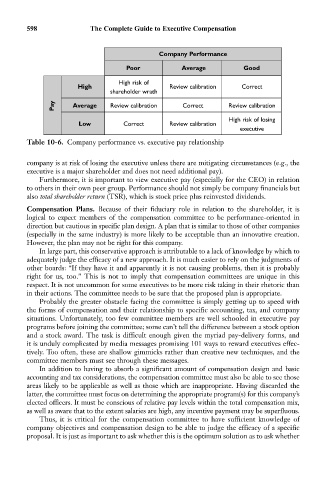Page 612 - Bruce Ellig - The Complete Guide to Executive Compensation (2007)
P. 612
598 The Complete Guide to Executive Compensation
Company Performance
Poor Average Good
High risk of
High Review calibration Correct
shareholder wrath
Pay Average Review calibration Correct Review calibration
High risk of losing
Low Correct Review calibration
executive
Table 10-6. Company performance vs. executive pay relationship
company is at risk of losing the executive unless there are mitigating circumstances (e.g., the
executive is a major shareholder and does not need additional pay).
Furthermore, it is important to view executive pay (especially for the CEO) in relation
to others in their own peer group. Performance should not simply be company financials but
also total shareholder return (TSR), which is stock price plus reinvested dividends.
Compensation Plans. Because of their fiduciary role in relation to the shareholder, it is
logical to expect members of the compensation committee to be performance-oriented in
direction but cautious in specific plan design. A plan that is similar to those of other companies
(especially in the same industry) is more likely to be acceptable than an innovative creation.
However, the plan may not be right for this company.
In large part, this conservative approach is attributable to a lack of knowledge by which to
adequately judge the efficacy of a new approach. It is much easier to rely on the judgments of
other boards: “If they have it and apparently it is not causing problems, then it is probably
right for us, too.” This is not to imply that compensation committees are unique in this
respect. It is not uncommon for some executives to be more risk taking in their rhetoric than
in their actions. The committee needs to be sure that the proposed plan is appropriate.
Probably the greater obstacle facing the committee is simply getting up to speed with
the forms of compensation and their relationship to specific accounting, tax, and company
situations. Unfortunately, too few committee members are well schooled in executive pay
programs before joining the committee; some can’t tell the difference between a stock option
and a stock award. The task is difficult enough given the myriad pay-delivery forms, and
it is unduly complicated by media messages promising 101 ways to reward executives effec-
tively. Too often, these are shallow gimmicks rather than creative new techniques, and the
committee members must see through these messages.
In addition to having to absorb a significant amount of compensation design and basic
accounting and tax considerations, the compensation committee must also be able to see those
areas likely to be applicable as well as those which are inappropriate. Having discarded the
latter, the committee must focus on determining the appropriate program(s) for this company’s
elected officers. It must be conscious of relative pay levels within the total compensation mix,
as well as aware that to the extent salaries are high, any incentive payment may be superfluous.
Thus, it is critical for the compensation committee to have sufficient knowledge of
company objectives and compensation design to be able to judge the efficacy of a specific
proposal. It is just as important to ask whether this is the optimum solution as to ask whether

